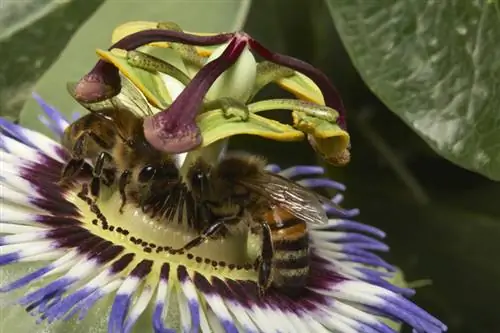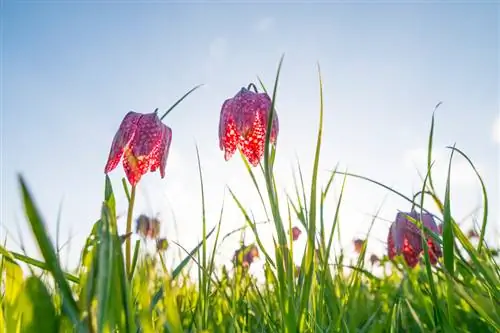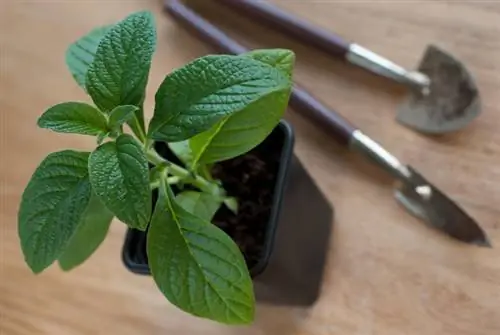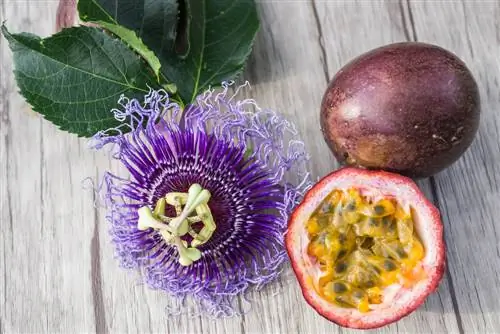- Author admin [email protected].
- Public 2023-12-16 16:46.
- Last modified 2025-06-01 06:02.
Passiflora is a family of plants with over 500 different species, most of which are native to South America. The passion fruit, which is often used in this country for multi-fruit juices, also belongs to this genus and can be easily cultivated from the seeds of purchased, ripe fruits. However, passion flowers are popular because of their wonderful, extraordinary flowers, which shine in a wide variety of colors depending on the type and variety. In addition, the plants are very easy to grow from seeds and often bloom in the first year. Caring for them is quite straightforward.
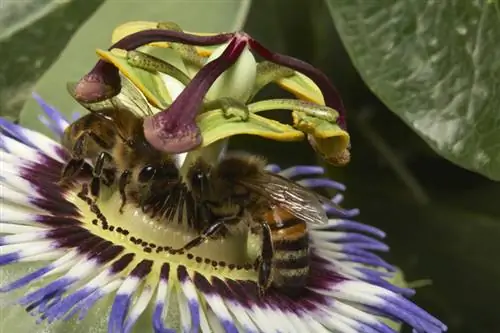
How do I properly care for a passion flower?
Caring for passionflower includes a bright, draft-free location, regular watering without waterlogging, mulching the substrate, fertilizing every 14 days with universal or flowering plant fertilizer and pruning in spring.
Can passionflower be cultivated as a houseplant?
Many passion flowers can be kept in the room without any problems, but they should be assigned a bright and draft-free location. However, Passiflora feels most comfortable in a warm and protected place in the garden or on the balcony. However, cat owners should think carefully about cultivating it, because the plant is poisonous for their four-legged friends.
Does the passion flower need to be watered a lot?
Passion flowers must not dry out under any circumstances, which is why the substrate is best mulched well. Mulching prevents the soil from drying out, for example due to strong sunlight, and can also be done on potted plants. Water the passionflower regularly and generously, but if possible, do not wet the leaves or flowers. Avoid waterlogging, for example by ensuring good drainage in the pot. The plant pot should definitely have several holes at the bottom so that excess water can drain away.
How often and with what should I fertilize the passion flower?
When it comes to fertilization, the passion flower is quite undemanding; a commercially available universal or flowering plant fertilizer is sufficient (€14.00 on Amazon). Give this every 14 days during the growing season together with the irrigation water. Alternatively, long-term fertilizers are of course also recommended, then don't forget to fertilize. In winter, passiflora kept indoors receive about a quarter of the usual amount, while specimens that have been kept cool over the winter are not fertilized at all.
Can I repot the passion flower?
Basically it is enough if passion flowers that are kept for several years are cultivated in a pot with a diameter of around 20 to 30 centimeters. The plants usually bloom better in smaller pots, while in larger pots they grow better and produce more leaves, but they also bloom less often. However, if your passiflora becomes too crowded, repot it in spring.
When and how does the passion flower have to be cut?
Passion flowers should be cut back heavily in early spring - around February / March - as the flowers usually appear on new shoots. Shorten the side shoots of the passion flower to around 10 centimeters and the main shoot to 15 to 20 centimeters. To do this, use a sharp and clean (risk of infection!) knife or scissors. By the way, cutting the shoot tips in a timely manner also means that the passionflower branches out more.
Which diseases commonly occur in passionflower?
High humidity, especially when overwintering in a warm room, often leads to mildew or botrytis / gray mold infestation of passionflowers. Both fungi cause a whitish to grayish coating, primarily on the leaves, which spreads quickly and must be removed and disposed of immediately due to the high risk of infection. At least spraying garlic or nettle decoction or a mixture of fresh whole milk and water (1:10 ratio) helps against mildew. When waterlogging occurs, various bacteria and fungi settle in the substrate, which ultimately causes the roots of the passionflower to mold and rot.
What pests should I watch out for when it comes to passionflower?
Plant lice such as mealybugs and mealybugs can become a problem, especially with passion flowers grown indoors, and infestation with spider mites is also not uncommon. These pests occur when the air is too dry, which is why you can prevent them quite well by regularly spraying the leaves and shoots of the passion flower. Otherwise, the leaves are very popular with ants: If the passionflower is in the garden, the little crawling creatures like to nibble on the greens.
What type of trellis does the passion flower need?
Passion flowers are climbing plants and therefore definitely need a climbing aid. A round arch makes sense for Passiflora kept indoors, as it cleverly accommodates the plant's otherwise huge growth height in a smaller space. However, a metal grid is recommended for passion flowers in the garden or on the balcony.
Is passionflower hardy?
No, because the passionflower comes from tropical or subtropical climates and absolutely needs frost-free overwintering. Even the varieties that some retailers declare to be “hardy” need a lot of protection and shouldn’t actually be left outside - which the same retailers often admit in the small print themselves.
How can I overwinter the passion flower?
Like many plants, the passion flower is grateful for a winter break. Overwintering should take place in a frost-free but cool and bright room in the house, winter garden or greenhouse. Water the passiflora little and stop fertilizing as early as August.
Tips & Tricks
Almost all passion flowers are perennial, with one exception: the very delicate, white-flowering Passiflora gracilis does not need much care and reliably produces many fruits from which you can then obtain seeds for the following year.

